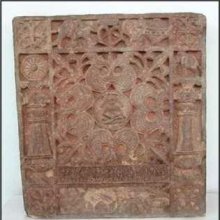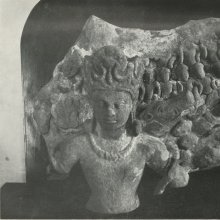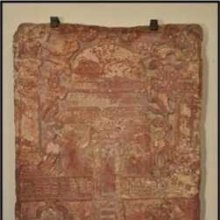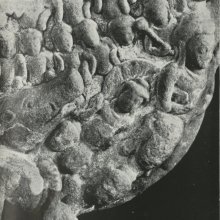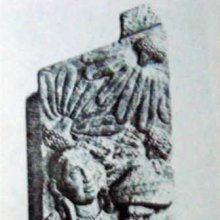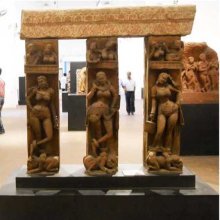Mathura, Mathurā, Māthura, Mathūrā, Mathur: 38 definitions
Introduction:
Mathura means something in Buddhism, Pali, Hinduism, Sanskrit, Jainism, Prakrit, the history of ancient India, Marathi, Hindi. If you want to know the exact meaning, history, etymology or English translation of this term then check out the descriptions on this page. Add your comment or reference to a book if you want to contribute to this summary article.
Images (photo gallery)
(+8 more images available)
In Hinduism
Vaishnavism (Vaishava dharma)
Source: ISKCON Press: GlossaryMathurā (मथुरा).—Lord Kṛṣṇa’s abode, and birth place, surrounding Vṛndāvana. At the end of Lord Kṛṣṇa’s manifest līlā, Vajra, His grandson, was put in charge of this sacred city. Lord Krsṇa displayed His pastimes after leaving Vṛndāvana. It is also the name of the district where Vraja (Vṛndāvana) is located.
Source: Acta Orientalia vol. 74 (2013): Historical sequence of the Vaiṣṇava DivyadeśasMathurā (or Bṛndāvanam, Govardhana) refers to Vaṭamaturai, one of the 108 Vaishnava Divya Desam (divyadeśas or divyasthalas), located in the topographical division of Vaṭanāṭu (“North India”), according to the 9th century Nālāyirativviyappirapantam (shortly Nālāyiram).—Tradition would record the Vaiṣṇava divyadeśas or divyasthalas are 108. The divyadeśa is a base of the cult of Viṣṇu in Viṣṇuism [Vaiṣṇavism] tradition. The list of 108 [viz., Mathurā] seems to have reached maturation by about the early 9th century CE as all the deśas are extolled in the hymns of the twelve Āḻvārs.
Source: Pure Bhakti: Brhad BhagavatamrtamMathurā (मथुरा) refers to:—The divine abode of Śrī Kṛṣṇa, where He appeared as the son of Vasudeva and Devakī, and where He performed His pastimes as a prince. Also refers to Mathurāmaṇḍala. (cf. Glossary page from Śrī Bṛhad-bhāgavatāmṛta).

Vaishnava (वैष्णव, vaiṣṇava) or vaishnavism (vaiṣṇavism) represents a tradition of Hinduism worshipping Vishnu as the supreme Lord. Similar to the Shaktism and Shaivism traditions, Vaishnavism also developed as an individual movement, famous for its exposition of the dashavatara (‘ten avatars of Vishnu’).
Purana and Itihasa (epic history)
Source: archive.org: Puranic EncyclopediaMathurā (मथुरा).—The birth place of Śrī Kṛṣṇa.
Source: archive.org: Shiva Purana - English Translation1) Mathurā (मथुरा) refers to one of the seven sacred cities of the Hindus, according to a footnote at the Śivapurāṇa-māhātmya chapter 1. Accordingly, —“[...] the holy rivers, Gaṅgā and others, the seven sacred cities [viz., Mathurā] and Gayā can never be equal to Śivapurāṇa. If one wishes for the greatest of goals (Liberation) one shall recite at least a stanza or even half of it from Śivapurāṇa. He who constantly listens to Śivapurāṇa fully comprehending its meaning or simply reads it with devotion is undoubtedly a meritorious soul”.
The seven sacred cities of the Hindus are: Ayodhyā, Mathurā, Māyā, Kāśī, Kāñcī, Āvantikā and Dvārikā.
2) Mathurā (मथुरा) is the name of a ancient country/region from where the Rudrākṣa trees are said to be very sacred, according to the Śivapurāṇa 1.25, while explaining the greatness of Rudrākṣa:—“[...] Rudrākṣas grown in Gauḍa land became great favourites of Śiva. They were grown in Mathurā, Laṅkā, Ayodhyā, Malaya, Sahya mountain, Kāśī and other places. They are competent to break asunder the clustered sins unbearable to the others, as the sacred texts have declared”.
Source: Cologne Digital Sanskrit Dictionaries: The Purana Index1a) Mathurā (मथुरा).—Founded by Śatrughna after killing Lavaṇa;1 capital of Subāhu and Śūrasena; here was celebrated the marriage of Vasudeva and Devakī when the couple were the recipients of rich presents of elephants, horses, dāsis and others; Kaṃsa joined in the festivities when a voice in the sky said that her eighth son was to kill him;2 visited by Nanda to pay his annual tribute; left by Nanda;3 capital of the Yadus, besieged by Jarāsandha and his followers; defended by the Yādavas on all the four sides; entered by Kṛṣṇa after defeating Jarāsandha; second attempt of Jarāsandha on the city with Bāṇa's army; entered by Kṛṣṇa after a third success over Jarāsandha;4 Rājamārga and sabhā of;5 with a huge army Kṛṣṇa and Rāma returned to; besieged by Yavana; abandoned by Kṛṣṇa in fear, for Dvārakā;6 reached by Rāma, Kṛṣṇa, Akrūra and others; Gopa's camp outside the city; entered by the brothers and Gopas; the city described; joy of the women at the sight of the brothers;7 left by Akrūra for Vraja by chariot, as also by Uddhava; Gopis' enquiry about Kṛṣṇa. Uddhava's return to Mathurā from Vraja.8 reached by Nanda, Gopas and Gopis after Vasudeva's sacrifice at Syamantapañcaka;9 Vajra anointed king of, by Yudhiṣṭhira;10 sometime ruled by seven Nāga kings;11 sacred to Devakī.12 Vasudeva's residence in;13 left by Akrūra in a chariot as directed by Kaṃsa to fetch Kṛṣṇa from Vraja; Kṛṣṇa's visit to, which travelling by chariot took one day;14 ruled by Kaṃsa and then Ugrasena;15 evacuated for fear of Kālayavana and migrated to Dvārakā,16 temple of Hari at.17
- 1) Bhāgavata-purāṇa IX. 11. 14; Brahmāṇḍa-purāṇa III. 63. 186; IV. 40. 19; Vāyu-purāṇa 88. 185-6; Viṣṇu-purāṇa IV. 4. 101.
- 2) Bhāgavata-purāṇa X. 1. 27-34; 2. 4.
- 3) Ib. X. 5. 19, 32; 6. 31.
- 4) Ib. X. 50. 4. 11 [1-9], 20 [1-5], 36-40. 50 (V) 6, [51 (V) 21-3], [52 (V) 9].
- 5) Ib. X. 50. 10-13.
- 6) Ib. X. 53 (V) 21-2, 50, 45, 53; 72. 31.
- 7) Ib. X. ch. 41 (whole); 42. 23.
- 8) Ib. X. 38. 1; 47. 21, 68.
- 9) Ib. X. 84. 69.
- 10) Ib. I. 15. 39.
- 11) Brahmāṇḍa-purāṇa III. 74. 194.
- 12) Matsya-purāṇa 13. 39.
- 13) Viṣṇu-purāṇa V. 3. 16.
- 14) Ib. V. 15. 24; 18. 9ff.
- 15) Ib. V. 19. 8 ff.
- 16) Ib. V. 21. 32; 23. 15.
- 17) Ib. VI. 8. 31.
1b) (Dakṣiṇa) visited by Balarāma.*
- * Bhāgavata-purāṇa X. 79. 15.
1c) The capital of the Nāgas of whom seven are distinguished.*
- * Vāyu-purāṇa 99. 383.
2) Māthura (माथुर).—A tribe; ended their lives by killing their own men.*
- * Bhāgavata-purāṇa X. 1. 27; XI. 30. 18.

The Purana (पुराण, purāṇas) refers to Sanskrit literature preserving ancient India’s vast cultural history, including historical legends, religious ceremonies, various arts and sciences. The eighteen mahapuranas total over 400,000 shlokas (metrical couplets) and date to at least several centuries BCE.
Kavya (poetry)
Source: archive.org: Aspects of Bengal society: Ship-building and commerceMathura is the name of an ancient city mentioned by the author of the Kavikankan’s Chandikāvya pp. 195-202.—Accordingly, after the performance of the usual ceremonies before sailing, the merchant Dhanapati passed the following places: [...]—all by the side of the Ganges. Then he reached the very celebrated inland port of Bengal known as Saptagram near the Tribeni. The poet here incidentally praised this port and gave it a superiour place among the following ports and places: [e.g., Mathura, etc...]. According to the poet the merchants of the above places visit Saptagram but the merchants of Saptagram do never visit those ports and places.
Source: Shodhganga: A critical appreciation of soddhalas udayasundarikathaMathurā (मथुरा).—One of the various countries and cities mentioned by Soḍḍhala.—Mathurā was the ancient capital of Surasena Janapada. Indrapura was its another name. It was a business centre as it was located on the high way of ancient India. The river Yamunā flows to the north of it. Soḍḍhala says that it was encircled by ditches. It was as it were a charm of Uttarāpatha through its excellent gradens. With wite-washed mansions it appeared as it were the fame of the human world. It was the residence of Kṛṣṇa in his childhood.

Kavya (काव्य, kavya) refers to Sanskrit poetry, a popular ancient Indian tradition of literature. There have been many Sanskrit poets over the ages, hailing from ancient India and beyond. This topic includes mahakavya, or ‘epic poetry’ and natya, or ‘dramatic poetry’.
Shilpashastra (iconography)
Source: Shodhganga: The significance of the mūla-beras (śilpa)Mathura Iconography.—The art form that emphasized the Indian idiom with idealistic symbolism that was indigenous to India was the one that developed in the city of Mathura. Mathura icons became popular all over the country and icons were prepared for commercial purposes also. The iconography that originated in Mathura (1st–2nd century AD) continued in the fourth century and developed and attained maturity in the golden age of the Guptas (4th–5th centuries).

Shilpashastra (शिल्पशास्त्र, śilpaśāstra) represents the ancient Indian science (shastra) of creative arts (shilpa) such as sculpture, iconography and painting. Closely related to Vastushastra (architecture), they often share the same literature.
Jyotisha (astronomy and astrology)
Source: Wisdom Library: Brihat Samhita by VarahamihiraMathura (मथुर) (Cf. Māthuraka) refers to a country belonging to “Madhyadeśa (central division)” classified under the constellations of Kṛttikā, Rohiṇī and Mṛgaśīrṣa, according to the system of Kūrmavibhāga, according to the Bṛhatsaṃhitā (chapter 14), an encyclopedic Sanskrit work written by Varāhamihira mainly focusing on the science of ancient Indian astronomy astronomy (Jyotiṣa).—Accordingly, “The countries of the Earth beginning from the centre of Bhāratavarṣa and going round the east, south-east, south, etc., are divided into 9 divisions corresponding to the 27 lunar asterisms at the rate of 3 for each division and beginning from Kṛttikā. The constellations of Kṛttikā, Rohiṇī and Mṛgaśīrṣa represent the Madhyadeśa or central division consisting of the countries of [i.e., Mathura] [...]”.

Jyotisha (ज्योतिष, jyotiṣa or jyotish) refers to ‘astronomy’ or “Vedic astrology” and represents the fifth of the six Vedangas (additional sciences to be studied along with the Vedas). Jyotisha concerns itself with the study and prediction of the movements of celestial bodies, in order to calculate the auspicious time for rituals and ceremonies.
General definition (in Hinduism)
Source: WikiPedia: HinduismIn Hinduism, Mathura is believed to be the birthplace of Krishna, which is located at the centre of the Shri Krishna Janmabhoomi. It is one of the Sapta Puri, the seven cities considered holy by Hindus. The Kesava Deo Temple was built in ancient times on the site of Krishna’s birthplace (an underground prison). Mathura was the capital of the kingdom of Surasena, ruled by Kamsa, the maternal uncle of Krishna.
In Buddhism
Theravada (major branch of Buddhism)
Source: Pali Kanon: Pali Proper NamesSee Madhura.
Theravāda is a major branch of Buddhism having the the Pali canon (tipitaka) as their canonical literature, which includes the vinaya-pitaka (monastic rules), the sutta-pitaka (Buddhist sermons) and the abhidhamma-pitaka (philosophy and psychology).
Mahayana (major branch of Buddhism)
Source: archive.org: Bulletin of the French School of the Far East (volume 5)Mathurā (मथुरा) (in Chinese: Mo-t'eou-lo) refers to one of the fifty-five kingdoms enumerated in chapter 17 of the Candragarbha: the 55th section of the Mahāsaṃnipāta-sūtra, a large compilation of Sūtras (texts) in Mahāyāna Buddhism partly available in Sanskrit, Tibetan and Chinese.—In the Candragarbhasūtra, the Bhagavat invites all classes of Gods and Deities to protect the Law [dharma?] and the faithful in their respective districts.—In Mathurā, the following deities are appointed (among others): The Gandharva Śuddhaprabha [?]; the Mahāyakṣa Naravāhana; the Nāgarāja Amala; the Asura Galaṃcari; the Kumbhāṇḍa Kālavarṇa; the Goddess Manoharī.
Mathurā (मथुरा) (in Chinese: Mo-t'eou-lo) is the name of an ancient kingdom associated with Ārdrā or Ārdrānakṣatra, as mentioned in chapter 18.

Mahayana (महायान, mahāyāna) is a major branch of Buddhism focusing on the path of a Bodhisattva (spiritual aspirants/ enlightened beings). Extant literature is vast and primarely composed in the Sanskrit language. There are many sūtras of which some of the earliest are the various Prajñāpāramitā sūtras.
General definition (in Buddhism)
Source: Wisdom Library: BuddhismMathura (मथुर) is the name of an ancient city found by the son of Sādhina: an ancient king from the Solar dynasty (sūryavaṃśa) and a descendant of Mahāsaṃmata, according to the Mahābuddhavaṃsa or Maha Buddhavamsa (the great chronicle of Buddhas) Anudīpanī chapter 1, compiled by Ven. Mingun Sayadaw. Purindeva (Surindeva or Munindeva in other versions) and his descendants in that city were twenty-eight. The last of these twenty-eight kings was named Sādhina. His son founded Mathura and reigned. He and his descendants in that city were twenty-two.
Source: academia.edu: The Chronological History of BuddhismMathura: a center of Buddhism (1765 BCE).—Divyavadana (Pamsupradanavadana) informs us that Buddha visited Mathura along with Ananda before his mahaparinirvana. Buddha foretold Ananda that Upagupta, the third son of Gupta (Gāndhika = a merchant of perfumes) , will establish Buddhism 100 years after nirvana. Evidently, Mathura emerged as a major center of Buddhism around 1765 BCE under the leadership of Upagupta I who was the contemporary of Bindusara I and Kalashoka. Two businessmen brothers named Nata and Bhata established a Vihara namely “Natabhatikā” on the hills of “Rurumunda” of Mathura. Upagupta I learnt Buddhism in this Vihara at Mathura.
In Jainism
General definition (in Jainism)
Source: archive.org: Sum Jaina Canonical Sutras (vividhatirthakalpa)Mathurā (मथुरा), Madhurā or Mathurāpurī is generally identified with Maholi five miles to the south-west of the present town of Mathurā or Muttra. It was the captial of the Śūrasena country built by Rāma’s brother Śatrughna after killing the Yādava Lavaṇa at the site of Madhuvana. Hence it was known as Madhupurī according to the Mahābhārata.
Two ascetics, Dharmaruci and Dharmaghoṣa used to dwell in Mathurā. Mathurā was then twelve yojanas long, nine yojanas broad, watered by the Yamunā, well-guarded by ramparts, and adorned with Hara-temples, Jina-houses, lakes, wells, tanks and fairs. Mathurā was a centre of heretical ascetics and was known for the pilgrimage to the teple of Bhaṇḍira Yakkha. The Vividhatīrthakalpa mentions the following gardens of Mathurā: tāla, bhaṇḍīra, kola, bahula, billa and lohajaṅgha. The place came to be known as Siddhakṣetra fro mthe perfection duly attained by the two sages.
This town is the birth-pace of Vāsudeva (Kṛṣṇa). Here are the temples of Ārya Maṅgu and Huṇḍiya Yakṣa. Here are these five notable spots: Arkasthala, Vīrasthala, Padmasthala, Kuśasthala, and Mahāsthala. Here are also to be seen these twelve forests: Lauhajaṅghavana, Madhuvana, Vilvavana, Tālavana, Kumudavana, Vṛndāvana, Bhaṇḍīravana, Khadiravana, Kāmikavana, Kolavana, Vahulāvana and Mahāvana. The five popular shirnes of the place are: Viśrāntika tīrtha, Asikuṇḍ-tīrtha, Vaikuṇṭha-tīrtha, Kāliñjara-tīrtha and Cakra-tīrtha.
Source: archive.org: Trisastisalakapurusacaritra1) Mathurā (मथुरा) is the birth-place of Kṛṣṇa: one of the nine black Vāsudevas, according to chapter 1.6 [ādīśvara-caritra] of Hemacandra’s 11th century Triṣaṣṭiśalākāpuruṣacaritra: an ancient Sanskrit epic poem narrating the history and legends of sixty-three illustrious persons in Jainism.
2) Mathurā (मथुरा) is the name of a city associated with Sauvīra, which refers to one of the 25½ countries of the Kṣetrāryas, situated in the “middle world” (madhyaloka), according to chapter 2.3.—Accordingly, “In these 35 zones on this side of Mānuṣottara and in the Antaradvīpas, men arise by birth; [...]. From the division into Āryas and Mlecchas they are two-fold. The Āryas have sub-divisions [e.g., kṣetra (country)]. [...] The kṣetrāryas are born in the 15 Karmabhumis. Here in Bharata they have 25½ places of origin (e.g., Sauvīra), distinguishable by cities (e.g., Mathurā) in which the birth of Tīrthakṛts, Cakrabhṛts, Kṛṣṇas, and Balas takes place”.
Source: HereNow4u: Lord Śrī MahāvīraMathurā (मथुरा) is the name of a village visited by Mahāvīra during his 24th Year as Kevalī.—Leaving Sāketa the Lord went to Kampilapura in Pāñcāla region. From there, wandering through Sūrasena, Mathurā, Nandīpura, etc, he came to Videha and spent the rainy season in Mithilā.

Jainism is an Indian religion of Dharma whose doctrine revolves around harmlessness (ahimsa) towards every living being. The two major branches (Digambara and Svetambara) of Jainism stimulate self-control (or, shramana, ‘self-reliance’) and spiritual development through a path of peace for the soul to progess to the ultimate goal.
India history and geography
Source: archive.org: Geography in Ancient Indian inscriptionsMathurā (मथुरा) or Madhurā.—Hathipumpha inscription of Khāravala refers to the city called Madhurā, i.e.. Mathurā, the famous city of the Śūrasenas. In five other inscriptions, four discovered from Mathurā or from its neighbourhood and one discovered at Bandhogarh, mention the persons belonging to this city. The mention of the inhabitants of Mathurā in Jaina inscriptions of the Kushana period is a proof of its being the centre of Jainism during that period. The majority of the inscriptions found at Mathura are Jain in character. An inscription of the time of Candragupta II dated in the year 61 of the Gupta era refers to Śaiva establishments of the Lakulīśa sect in this city.
Source: Wikipedia: India HistoryMathura is a city in the North Indian state of Uttar Pradesh. It is located approximately 50 kilometres (31 mi) north of Agra, and 145 kilometres (90 mi) south-east of Delhi; about 11 kilometres (6.8 mi) from the town of Vrindavan, and 22 kilometres (14 mi) from Govardhan. Mathura has an ancient history and also homeland and birthplace of Krishna who was born in Yadu dynasty. According to the Archaeological Survey of India plaque at the Mathura Museum, the city is mentioned in the oldest Indian epic, the Ramayana. In the epic, the Ikshwaku prince Shatrughna slays a demon called Lavanasura and claims the land. Afterwards, the place came to be known as Madhuvan as it was thickly wooded, then Madhupura and later Mathura.
In the 6th century BCE Mathura became the capital of the Surasena Kingdom. The city was later ruled by the Maurya empire (4th to 2nd centuries BCE). Megasthenes, writing in the early 3rd century BCE, mentions Mathura as a great city under the name Μέθορα (Méthora). After a period of local rule, Mathura was conquered by the Indo-Scythians during the 1st century BCE. The Indo-Scythian satraps of Mathura are sometimes called the "Northern Satraps", as opposed to the “Western Satraps” ruling in Gujarat and Malwa.
Faxian mentions the city as a centre of Buddhism about 400 CE while his successor Xuanzang, who visited the city in 634 CE, mentions it as Mot'ulo, recording that it contained twenty Buddhist monasteries and five Brahmanical temples.
Source: Shodhganga: New look on the kushan bengaliMathura is the most important Kushan site in India. It had functioned as the eastern capital of the Kushan empire. The city has provided evidence of the most prolonged Kushan occupation. The excavation revealed five periods of occupation of which period III-IV is assignable to early centuries of Christian era. A large number of inscriptions belonging to the Kushan kings were discovered from the various sites around Mathura. Numerous sculptures and a few epigraphs of Kushan periods were also discovered. Six of which belonged to Huvishka.
Source: Knowledge Traditions & Practices of India: Architecture (1): Early and Classical Architecture (h)Mathura is an archaeologically important site dating to the Ganges civilization (1000 BCE).—Nearly a millennium after the Indus civilization had collapsed, the Ganges civilization arose in the first millennium BCE. Among the first cities were, for example, Mathura in today’s Uttar Pradesh.
Source: Ancient Buddhist Texts: Geography of Early BuddhismMathurā (मथुरा) (modern Maholi), also spelled as Madhurā was the ancient capital of Sūrasena: one of the sixteen Mahājanapadas of the Majjhimadesa (Middle Country) of ancient India, as recorded in the Pāli Buddhist texts (detailing the geography of ancient India as it was known in to Early Buddhism).—In the Aṅguttara Nikāya, the Sūrasena country is mentioned as one of the sixteen Mahājanapadas. The country had its capital at Madhurā or Mathurā, which like Kausāmbī stood on the river Yamunā. Mathurā or Madhurā is generally identified with Maholi, 5 miles to the south-west of the present town of Mathurā or Muttra. The ancient Greek writers refer to the Sūrasena country as Sourasenoi and its capital as Methora. When Megasthenes wrote about the Sūrasenas, Mathurā must have formed a part of the Maurya Empire.
There was a second Mathurā or Madhurā in ancient India. It was the second capital of the Pāṇḍya kingdom on the river Vaigi, in the province of Madras. It was called Dakṣiṇa Mathurā to distinguish it from Mathurā of the north.
Buddhism was predominant in Mathurā for several centuries. The Vimānavatthu Commentary tells us of a woman of Uttarā Madhurā who by offering alms to the Buddha was reborn in the Tāvatiṃsa heaven. During the Kushana supremacy, Mathurā again became important as a centre of Buddhist religion and culture. Numerous dated and undated images of Buddhas and Bodhisattwas as well as inscriptions have been unearthed here.
Source: What is India: Inscriptions of the ParamarasMathurā (मथुरा) (in Uttar Pradesh) is the name of a village mentioned in the “Māndhātā copper-plate inscription of Devapāla”. These copper plates (mentioning Mathurā) were discovered in 1905 in the former State of Dhār, near the temple of Siddheśvara at Māndhātā, better known by the longer name Oṃkāra-Māndhātā (an island in the Narmadā attached to the East Nemāḍ District in Madhya Pradesh). It records the donation of the village of Satājunā in the Mahuaḍa Pratijāgaraṇaka, by Devapāla. It is dated on the full moon day of Bhādrapada in the (Vikrama) year 1282, which corresponds to the 19th August, 1225 A.C.
Source: OpenEdition books: Vividhatīrthakalpaḥ (History)Mathurā (मथुरा) is the name of an ancient locality, associated with a pilgrimage route, as is mentioned in the Vividhatīrthakalpa by Jinaprabhasūri (13th century A.D.): an ancient text devoted to various Jaina holy places (tīrthas).
Source: academia.edu: Tessitori Collection I (history)Māthura (माथुर) refers to one of the twelve Kāyastha groups from Māthurā, according to the “Samoṣaṇa Kāitha Māthura-rāsa” (dealing with caste history), and is included in the collection of manuscripts at the ‘Vincenzo Joppi’ library, collected by Luigi Pio Tessitori during his visit to Rajasthan between 1914 and 1919.—In between the work deals with the legendary origin of the Kāyasthas as sons of Citragupta, himself born from Brahmā’s body. The Māthura Kāyasthas are one of the twelve Kāyastha groups. (See partial list, e.g., Māthura, [...]).

The history of India traces the identification of countries, villages, towns and other regions of India, as well as mythology, zoology, royal dynasties, rulers, tribes, local festivities and traditions and regional languages. Ancient India enjoyed religious freedom and encourages the path of Dharma, a concept common to Buddhism, Hinduism, and Jainism.
Languages of India and abroad
Marathi-English dictionary
Source: DDSA: The Molesworth Marathi and English Dictionarymathurā (मथुरा).—f (S) A town in the province of Agra, celebrated as the birthplace of kṛṣṇa. It is a place of pilgrimage.
Marathi is an Indo-European language having over 70 million native speakers people in (predominantly) Maharashtra India. Marathi, like many other Indo-Aryan languages, evolved from early forms of Prakrit, which itself is a subset of Sanskrit, one of the most ancient languages of the world.
Sanskrit dictionary
Source: DDSA: The practical Sanskrit-English dictionaryMathurā (मथुरा) or Mathūrā (मथूरा).—[math-u-ū-rac] Name of an ancient town situated on the right bank of the Yamunā, the birth-place of Kṛṣṇa and the scene of his amours and exploits; it is one of the seven sacred cities in India (see avanti), and is, to this day, the favourite resort of thousands of devotees. It is said to have been founded by Śatrughna; निर्ममे निर्ममोऽर्थेषु मथुरां मधुराकृतिः (nirmame nirmamo'rtheṣu mathurāṃ madhurākṛtiḥ) R.15.28; कलिन्दकन्या मथुरां गताऽपि गङ्गोर्मिसंसक्तजलेव भाति (kalindakanyā mathurāṃ gatā'pi gaṅgormisaṃsaktajaleva bhāti) 6.48.
--- OR ---
Māthura (माथुर).—a. (-rī f.) [मथुरायां भवो मथुराया आगतो वा अण् (mathurāyāṃ bhavo mathurāyā āgato vā aṇ)]
1) Coming from Mathurā.
2) Produced in Mathurā.
3) Dwelling in Mathurā.
-rī A kind of वृत्ति (vṛtti).
Source: Cologne Digital Sanskrit Dictionaries: Shabda-Sagara Sanskrit-English DictionaryMathurā (मथुरा).—f.
(-rā) A town in the province of Agra, celebrated as the birth place, and early residence of Krishna, and still an object of pilgrimage amongst the Hindus. E. math to stir, Unadi aff. urac .
--- OR ---
Mathūrā (मथूरा).—f. Mathura. E. ūrac affixed to mathi, instead of urac .
Source: Cologne Digital Sanskrit Dictionaries: Benfey Sanskrit-English DictionaryMathurā (मथुरा).—f. A district and city now called Muttra, [Pañcatantra] 8, 14.
Source: Cologne Digital Sanskrit Dictionaries: Cappeller Sanskrit-English DictionaryMathura (मथुर).—[masculine] [Name] of a man, [feminine] ā [Name] of [several] cities.
--- OR ---
Māthura (माथुर).—[feminine] ī coming from or belonging to Mathura; [masculine] an inhabitant of [Middle], a man’s name.
Source: Cologne Digital Sanskrit Dictionaries: Monier-Williams Sanskrit-English Dictionary1) Mathura (मथुर):—m. (√math?) Name of a man (cf. māthura)
2) Mathurā (मथुरा):—[from mathura] a f. See next.
3) [v.s. ...] b f. Name of various towns ([especially] of an ancient town now called Muttra and held in great honour as the birthplace of Kṛṣṇa; situated in the province of Agra on the right bank of the Yamunā or Jumna; described in [Viṣṇu-purāṇa xii, 1] as having been founded by Śatru-ghna; [according to] to [Manvarthamuktāvalī, kullūka bhaṭṭa’s Commentary on manu-smṛti on Manu-smṛti ii, 19] it forms part of a district called Brahmarṣi, belonging to Śūra-sena), [Atharva-veda.Pariś.; Harivaṃśa; Purāṇa etc.]
4) Mathūrā (मथूरा):—[from mathura] f. = mathurā above, [cf. Lexicographers, esp. such as amarasiṃha, halāyudha, hemacandra, etc.]
5) Māthura (माथुर):—mf(ī)n. coming from or born in or belonging to Mathurā, [Harivaṃśa; Kathāsaritsāgara]
6) relating or belonging to Mathurā, [Catalogue(s)]
7) composed by Mathurā-nātha, [ib.]
8) m. an inhabitant of Mathurā, [Harivaṃśa]
9) Name of a son of Citra-gupta, [Catalogue(s)]
10) of the keeper of a gambling house, [Mṛcchakaṭikā]
Source: Cologne Digital Sanskrit Dictionaries: Yates Sanskrit-English Dictionary1) Mathurā (मथुरा):—(rā) 1. f. A town in the province of Agra, where Krishna was born and brought up.
2) Mathūrā (मथूरा):—(rā) 1. f. Mathurā.
Source: DDSA: Paia-sadda-mahannavo; a comprehensive Prakrit Hindi dictionary (S)Māthura (माथुर) in the Sanskrit language is related to the Prakrit word: Māhura.
[Sanskrit to German]
Sanskrit, also spelled संस्कृतम् (saṃskṛtam), is an ancient language of India commonly seen as the grandmother of the Indo-European language family (even English!). Closely allied with Prakrit and Pali, Sanskrit is more exhaustive in both grammar and terms and has the most extensive collection of literature in the world, greatly surpassing its sister-languages Greek and Latin.
Hindi dictionary
Source: DDSA: A practical Hindi-English dictionaryMāthura (माथुर) [Also spelled mathur]:—(a) belonging to or related with the ancient cultural city of Mathura: (Uttar Pradesh).
Source: DDSA: A practical Hindi-English dictionaryMathur in Hindi refers in English to:—(a) belonging to or related with the ancient cultural city of Mathura: (Uttar Pradesh)..—mathur (माथुर) is alternatively transliterated as Māthura.
...
See also (Relevant definitions)
Starts with (+27): Mathuracampu, Mathuradasa, Mathuradeshya, Mathuraguhyavarnana, Mathuraka, Mathurakanda, Mathuramahatmya, Mathuramahatmyasamgraha, Mathuramahima, Mathuramahiman, Mathuramandala, Mathuranataka, Mathuranatha, Mathuranatha cakravartin, Mathuranatha sharman, Mathuranatha shukla, Mathuranatha tarkavagisha, Mathuranathajatimala, Mathuranathakrodapattrani, Mathuranatharaya.
Ends with: Pandyamathura.
Full-text (+437): Shurasena, Madhupaghna, Mathuresha, Mathuradeshya, Mathuraka, Govardhana, Madhura, Madhupuri, Mathuranatha, Mathuramahatmya, Mathuranathiya, Mathuramahiman, Mathurasetu, Mathurakanda, Mathuracampu, Nagasthala, Mathuramahatmyasamgraha, Mathuraguhyavarnana, Mathuratirthamahatmya, Mathuranathajatimala.
Relevant text
Search found 124 books and stories containing Mathura, Mathurā, Māthura, Mathūrā, Mathur; (plurals include: Mathuras, Mathurās, Māthuras, Mathūrās, Mathurs). You can also click to the full overview containing English textual excerpts. Below are direct links for the most relevant articles:
Garga Samhita (English) (by Danavir Goswami)
Verse 2.1.45 < [Chapter 1 - Description of the Entrance in Vṛndāvana]
Verse 2.1.11 < [Chapter 1 - Description of the Entrance in Vṛndāvana]
Verse 4.14.31 < [Chapter 14 - The Story of the Jālandharīs]
Brihad Bhagavatamrita (commentary) (by Śrī Śrīmad Bhaktivedānta Nārāyana Gosvāmī Mahārāja)
Verse 2.1.53 < [Chapter 1 - Vairāgya (renunciation)]
Verse 2.1.219 < [Chapter 1 - Vairāgya (renunciation)]
Verse 2.3.185 < [Chapter 3 - Bhajana (loving service)]
The Padma Purana (by N.A. Deshpande)
Chapter 48 - The Story of Padmāvatī < [Section 2 - Bhūmi-khaṇḍa (section on the earth)]
Chapter 246 - Jarāsandha Defeated < [Section 6 - Uttara-Khaṇḍa (Concluding Section)]
Chapter 73 - The Greatness of Mathurā < [Section 5 - Pātāla-Khaṇḍa (Section on the Nether World)]
Sahitya-kaumudi by Baladeva Vidyabhushana (by Gaurapada Dāsa)
Text 4.45 < [Chapter 4 - First-rate Poetry]
Text 7.40 < [Chapter 7 - Literary Faults]
Text 10.149 < [Chapter 10 - Ornaments of Meaning]
Bhakti-rasamrta-sindhu (by Śrīla Rūpa Gosvāmī)
Verse 1.2.237 < [Part 2 - Devotional Service in Practice (sādhana-bhakti)]
Verse 1.2.211 < [Part 2 - Devotional Service in Practice (sādhana-bhakti)]
Verse 1.3.40 < [Part 3 - Devotional Service in Ecstasy (bhāva-bhakti)]
Related products
